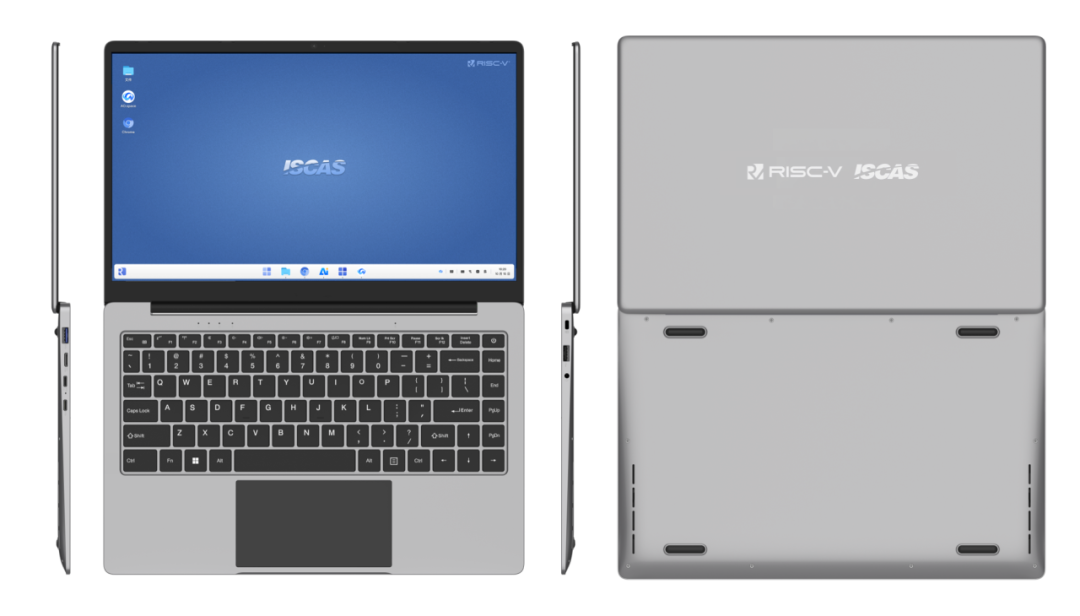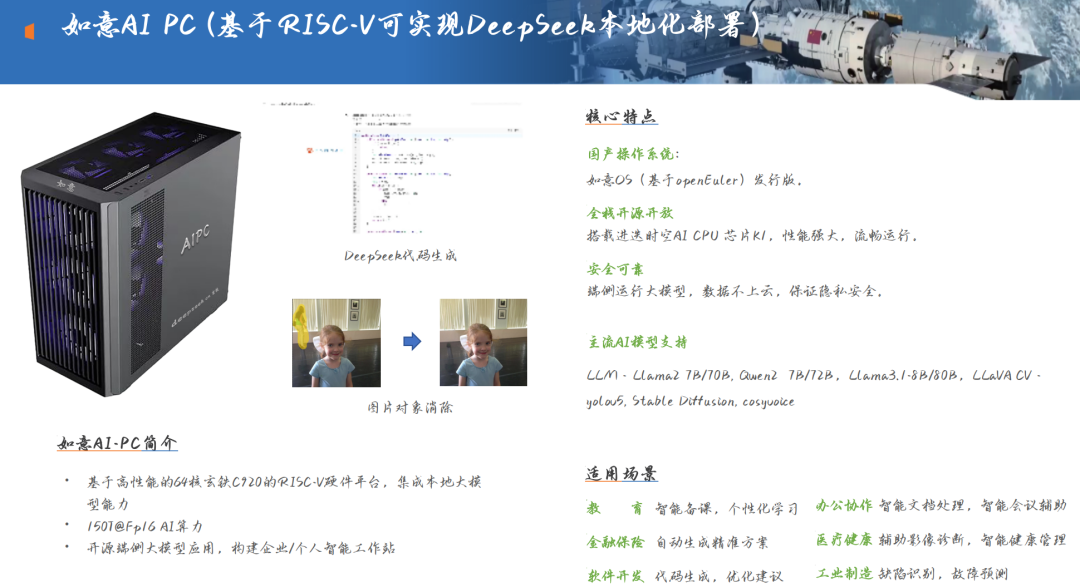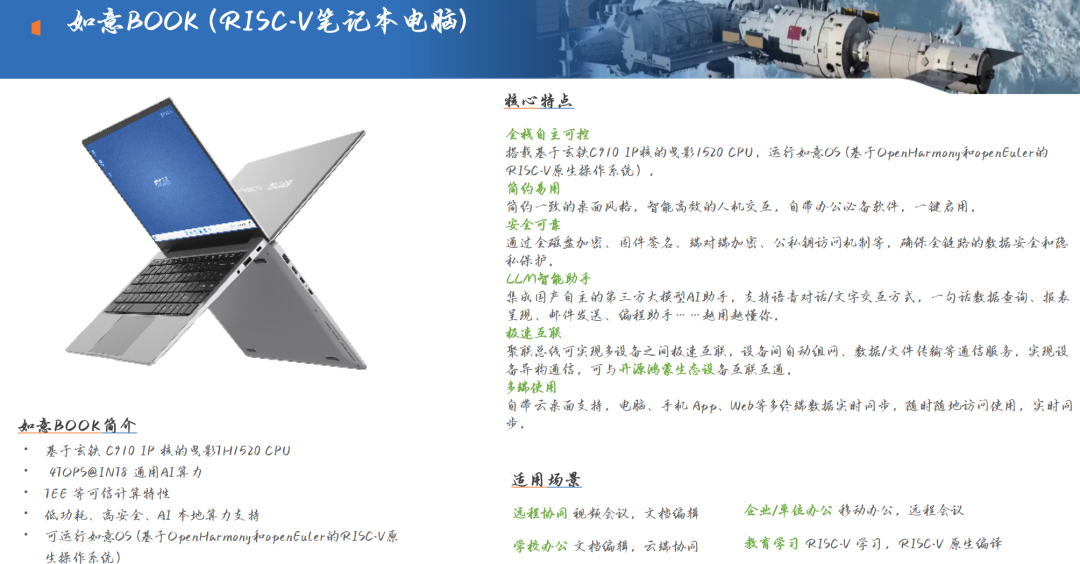Click Innovation Insights and mark it as a star⭐️ to get the latest news promptly

Editor’s Note:The “Ruyi BOOK Jiachen Version” equipped with the Xuantie C910 processor and Ruyi OS has been selected as a typical case by the Ministry of Industry and Information Technology, showcasing the groundbreaking potential of the RISC-V open source architecture. As the only mainstream instruction set that is “born open source,” the Xuantie C910 processor of the RISC-V open source architecture approaches ARM performance with a 12nm process, 1.85GHz main frequency, and 4TOPS AI computing power, while establishing a trusted environment through a full-stack security mechanism. Its intelligent leap is reflected in the collaborative design of the Vector/Scalar in the Yiying TH1520 processor, combined with the RiVAI Studio IDE to achieve a 30% improvement in large model inference performance, balancing privacy and efficiency for local AI on the edge. At the operating system level, Ruyi OS integrates OpenHarmony and openEuler, enabling multi-end collaboration and heterogeneous communication, covering scenarios in education, government, and industry. In the future, RISC-V needs to benchmark against X86/ARM high-end performance to reshape the global computing landscape through open source collaboration..
Editor|Innovation Insights Public Account (ID: xinchuangzh)Produced by | Andong StudioAuthor|AndongReprint|Please indicate the source

Scan to join the “Innovation Insights” knowledge community and obtain more information related to innovation and digitalization
01
Open Source Laptop Selected as a Typical Case by the Ministry of Industry and Information Technology
At the end of December 2024, the Ministry of Industry and Information Technology announced the list of 2024 “Typical Application Cases of Advanced Computing Empowering New Quality Productivity.” The open source laptop “Ruyi BOOK Jiachen Version,” developed by the Intelligent Software Research Center of the Institute of Software, Chinese Academy of Sciences, in collaboration with the Xuantie team of Alibaba DAMO Academy, was selected as one of the 73 typical application cases nationwide, centered around the RISC-V architecture.

As the first open source laptop based on the RISC-V architecture, the “Ruyi BOOK Jiachen Version” is equipped with the Xuantie C910 processor and Ruyi OS, integrating the toolchain Ruyi SDK, and for the first time, it connects the entire link from the underlying chip to the operating system to commercial software. Its release marks the landing of RISC-V general-purpose high-performance terminal products, promoting the development of the RISC-V ecosystem and enriching the full-stack autonomous shelf of chips and operating systems.
The Ruyi BOOK not only meets consumer user needs but also satisfies the needs of ecological developers, facilitating the integration of domestic open source operating systems with the RISC-V ecosystem. Currently, the research team is collaborating with ecological partners to further port and optimize mainstream software such as the Chromium browser, VS Codium, and DingTalk, improving the RISC-V software ecosystem in high-performance scenarios to provide users with a stable and smooth laptop experience.
In the future, the Ruyi BOOK will integrate an AI assistant, supporting not only basic office tasks, web browsing, video playback, casual games, and chatting but also serving as a RISC-V programming assistant to aid in native RISC-V development.

Sample image of the “Ruyi BOOK Jiachen Version”
The Ruyi BOOK, a domestic open source laptop based on the RISC-V architecture, not only signifies a significant breakthrough for China in the autonomous and controllable computing ecosystem but also reveals the profound changes occurring in the global chip industry landscape. As the only “born open source” architecture among mainstream instruction sets, RISC-V is reconstructing the underlying logic of technological innovation with its open source genes, paving a third development path in performance breakthroughs, ecosystem construction, and intelligent integration.
02
Potential of Open Source Architecture: From “Technological Democracy” to Performance Breakthrough
The birth of RISC-V stems from the idealism of academia—breaking the technological monopoly of traditional giants through a completely open instruction set architecture. Unlike the closed licensing models of X86 and ARM, RISC-V allows global developers to freely use, modify, and extend its design, providing a “democratization of architecture” that offers small and medium enterprises and innovative teams a ticket to participate in high-end chip development.
Academician Ni Guangnan of the Chinese Academy of Engineering pointed out that the key to the prosperity of the RISC-V ecosystem lies in building a positive cycle of “performance-ecosystem.” Taking the Xuantie C910 as an example, this processor, which uses a 12nm process, has a main frequency of 1.85GHz and AI computing power of 4TOPS (INT8), its performance is already approaching mainstream ARM architectures. More importantly, the Ruyi BOOK constructs a full-stack trusted computing environment from chip to system through security mechanisms such as full disk encryption and firmware signing. This “security gene” is not only a core demand for domestic production but also a differentiated advantage of open source architecture in commercial competition.
03
AI Computing Power Explosion: RISC-V’s Intelligent Leap
In the context of explosive growth in AI computing power demand, RISC-V demonstrates unique architectural flexibility. Among the 25 new standards approved by the RISC-V International Foundation in 2024, more than half focus on high-performance computing and AI acceleration, marking that this architecture has broken through traditional embedded fields and officially entered complex scenarios such as data centers and smart terminals.
The Yiying TH1520 processor equipped in the Ruyi BOOK Jiachen Version, through the collaborative design of the Vector Core and Scalar Core, combined with the open-source RiVAI Studio IDE from Ruisi Semiconductor, can achieve multi-core debugging and vector computing optimization. This soft-hard collaborative innovation allows the laptop to improve performance by over 30% when running large model inference. Meanwhile, Ruyi OS deeply adapts to open-source models such as DeepSeek and Stable Diffusion, constructing a new paradigm of edge intelligent computing—data can be localized for inference without needing to go to the cloud, balancing privacy security and real-time response.

04
Ecological Collaboration: “Technical Feedback” from the Open Source Community
The prosperity of the open source ecosystem relies on technical feedback and community co-construction. Ruisi Semiconductor, as a leading enterprise in the RISC-V field, has not only open-sourced the world’s first GCC compiler supporting the RVV1.0 standard (the code has been merged into the official GCC upstream repository) but also launched the RISC-V integrated development environment RiVAI Studio based on VSCode. This IDE supports multi-core debugging, performance analysis, and vector computing development, significantly lowering the development threshold for RISC-V.
At the operating system level, Ruyi OS, based on the innovative integration of OpenHarmony and openEuler, achieves multi-end collaboration among tablets, laptops, and cloud desktops, and breaks through the heterogeneous communication barriers between devices through the Julei bus technology. This ecological collaboration effect has already landed in multiple scenarios: in the education sector, the “Ruyi BOOK + Cloud Desktop” solution covers remote teaching in over 10 universities; in government offices, full-stack domestic hardware and national secret algorithm encryption systems provide trusted solutions for processing confidential information; and in the industrial control field, the real-time operating system EulixOS based on RISC-V is reconstructing the smart manufacturing infrastructure through containerization technology.
05
Challenges and Future: Performance Benchmarking and Global Market
Despite the enormous potential of RISC-V, its path to globalization still faces challenges. Ni Guangnan emphasized that RISC-V needs to benchmark against X86 and ARM in performance and open the mainstream market door through high-level IP design. Currently, the performance of domestic chips such as the Xuantie C910 is approaching the mid-range level of ARM, but breakthroughs are still needed in high-end servers and supercomputing fields.
It is worth looking forward to the fact that the open source model of RISC-V is attracting global developers to join. From the cooperation between Ruisi Semiconductor and domestic and foreign open source communities to the adaptation of Ruyi OS with mainstream AI frameworks, the “snowball effect” of the open source ecosystem is becoming evident. On November 21, 2024, at the Open Source Ecological Development Forum of the World Internet Conference in Wuzhen, the RISC-V software co-construction platform—”Ruyi RISC-V Community” was officially launched. This platform was jointly released by the Institute of Software, Chinese Academy of Sciences, the RISC-V Working Committee of the China Electronic Standardization Association, Alibaba DAMO Academy (Hangzhou) Technology Co., Ltd., and Beijing SuanNeng Technology Co., Ltd. This release not only gathered extensive attention from the industry but also marked a solid step for the RISC-V ecosystem in China.
As an important promoter of RISC-V technology development, the “Ruyi RISC-V Community” provides industry users with a full-chain software solution covering operating systems, toolchains, and applications through a co-construction model. By maintaining a rich software and hardware ecosystem, it provides comprehensive support for the application of RISC-V processors in multiple fields, assisting in the migration and adaptation of open source software projects. Currently, the Ruyi operating system developed by the software institute, as the native operating system of the RISC-V architecture, has successfully adapted to the chip products of multiple leading units, supporting various mainstream hardware; the software adaptation based on OpenHarmony and openEuler also demonstrates strong functionality and application capabilities.
As Ni Guangnan said: “When the openness of architecture meets performance breakthroughs, and when technological innovation resonates with scene demands, the domestic computing industry can not only achieve security and controllability but also give birth to disruptive innovation through open source collaboration.”

Conclusion
The success of the Ruyi BOOK Jiachen Version is a microcosm of the RISC-V open source revolution. In this silent architectural revolution, China is using the open source ecosystem as a fulcrum to pry open the power map of the global chip industry. In the future, as performance continues to break through and the ecosystem matures, RISC-V may become the “third pole” of computing architecture in the AI era, and the “shortcut” for domestic chips will be even broader due to open source.
About Andong:Founder of the public accounts “Innovation Insights,” “Innovation Consulting,” and “New Infrastructure Construction”; columnist; senior engineer evaluated by the Beijing Human Resources and Social Security Bureau, bidding expert, and specially invited expert of the Beijing Information Association; certified registered consulting engineer (investment) by the China Engineering Consulting Association; special lecturer for the “Innovation Consulting Planning” course at the Guangzhou Innovation Industry Association and Taiji Innovation Research Institute; graduated with a master’s degree in computer and systems engineering from Beijing Jiaotong University; has worked in several central state-owned enterprises, engaging in consulting research for many years in the fields of innovation industry and policy, digital government, smart cities, and intelligent transportation; welcome to communicate and cooperate! WeChat ID: andon902
Benefits
Positioning: This is a knowledge community I have carefully created, mainly covering innovation, digitalization, new infrastructure, smart cities, as well as AI, big data, and other new generation information technologies. I hope to build this knowledge community into a platform for frequent communication, consultation, and discussion of industry issues! Accompanying industry elites.
At the same time, I will provide a wealth of high-value online training and video replays, and offer some solutions/industry reports/PPT templates/e-books and other valuable materials for free[Currently 5000+, and updated in real-time], for everyone to communicate, learn, and improve themselves.
Welcome to join the Innovation Insights Think Tank(Scan the QR code below)


END


Click the image to view the full content:




